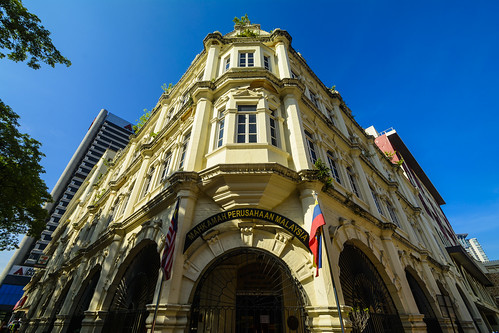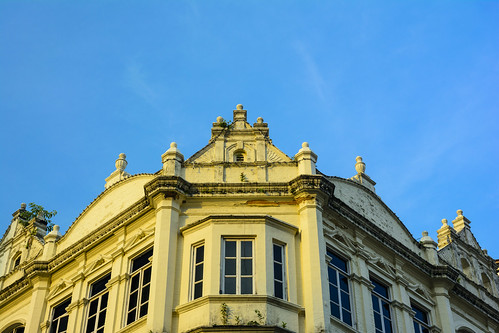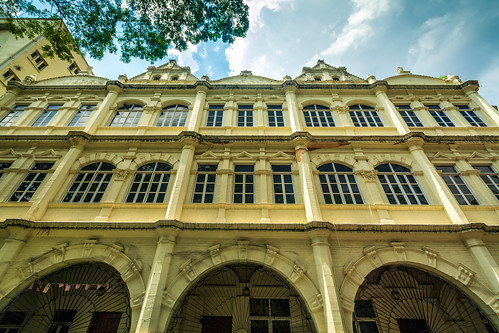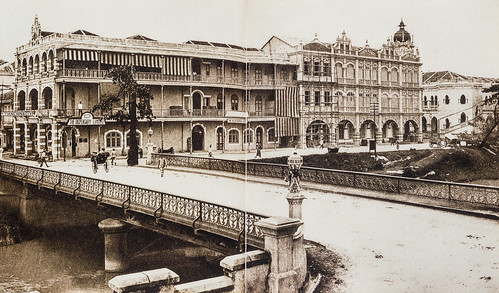Formerly Chow Kit & Co. Department Store - The first ever department store in Kuala Lumpur
 |
| The double-frontage former Chow Kit & Co. Department Store |
This architectural gem is different in its design from its neighbouring historic buildings originally occupied by the British government departments during colonial time. Those buildings including the Sultan Abdul Samad Building were designed in Indo-Saracenic architecture which have Islamic architectural influence intended to please especially the Malay Muslim Sultans and the local Malays.
According to the late Chen Voon Fee, a renowned local architect who co-founded Badan Warisan Malaysia (The Malaysian Heritage Trust), this classic building was designed in Neo-Renaissance architectural style by an Anglo-Indian architect, Abdul Kadir Moosdeen or more popularly known as AK Moosdeen. One of the prominent features in AK Moosdeen’s architectural works is the Dutch gable or also called Flemish gable and note the oriel windows at the corner of the building.
AK Moosdeen was Loke Yew's preferred choice of architect for besides this building, AK Moosdeen was also the architect of a row of shophouses in the Old Market Square (now Medan Pasar) and the Loke Hall (PAM Centre) on Jalan Tangsi (formerly Barracks Road) which were all Loke Yew's projects.
 |
| The flemish gable and oriel window |
 |
| Oriel window |
This edifice is situated at the corner of Clarke Street (now Jalan Mahkamah) and Holland Road (now Jalan Mahkamah Persekutuan) on the banks of the Klang River just downstream from the Jamek Mosque.
Built in 1905 by Loke Yew, one of Kuala Lumpur’s first multimillionaires and philanthropists, it was then leased to Loke Chow Kit, another prominent Chinese tycoon in Kuala Lumpur, who opened Chow Kit & Co., a department store, in September 1905.
Prior to its opening, the Malay Mail as the leading newspaper at that time, had the privilege to visit it in August of the same year. The Malay Mail described the new block of this three-storey building as “the handsomest edifice of its kind ever erected in Kuala Lumpur”.
It was said to have been the first department store in Kuala Lumpur catering mostly to the customers comprising British expatriates and members of the high society in then British Malaya.
A short passage in the book entitled ‘Twentieth Century Impressions of British Malaya…’, published in colonial times (1908), describes Messrs Chow Kit & Co as follows:
‘Messrs. Chow Kit & Co. are the largest storekeepers in Kuala Lumpur. Their commodious premises at the corner of Holland Road and Clarke Street are easily noticeable. From the small store which, on its establishment in 1892, had a staff of six, the business has grown until to-day its numerous branches give employment to about one hundred assistants. The business is that of a general store, with agencies for many London firms and life and fire insurance companies. The proprietors are Messrs. Loke Chow Kit (Kuala Lumpur), Ho Kim Kee (Pinang), Lim Chin Guan (Pinang), and Teh Seow Teng (Kuala Lumpur). The tailoring department was opened by the last named, and the wholesale and millinery by Mr. Lim Chin Guan. The printing department, first known as the Malayan Supply Company, was amalgamated with Chow Kit & Co. when Mr. Khoo Keng Hooi became their manager. The tailoring and millinery departments are under European supervision, the former having become famous owing to its creation of a new dress of a semi-European style, which has been adopted by practically all the better-class Chinese in Kuala Lumpur.’ …
This handsome edifice was renovated and restored in 1982 by another renowned local architect, Dato' Ar. Hajeedar bin Abdul Majid. It currently houses the Industrial Court of Malaysia.
Prior to its opening, the Malay Mail as the leading newspaper at that time, had the privilege to visit it in August of the same year. The Malay Mail described the new block of this three-storey building as “the handsomest edifice of its kind ever erected in Kuala Lumpur”.
It was said to have been the first department store in Kuala Lumpur catering mostly to the customers comprising British expatriates and members of the high society in then British Malaya.
 |
| The Malaysian Industrial Court Building is formerly Chow Kit & Co. Department Store |
A short passage in the book entitled ‘Twentieth Century Impressions of British Malaya…’, published in colonial times (1908), describes Messrs Chow Kit & Co as follows:
‘Messrs. Chow Kit & Co. are the largest storekeepers in Kuala Lumpur. Their commodious premises at the corner of Holland Road and Clarke Street are easily noticeable. From the small store which, on its establishment in 1892, had a staff of six, the business has grown until to-day its numerous branches give employment to about one hundred assistants. The business is that of a general store, with agencies for many London firms and life and fire insurance companies. The proprietors are Messrs. Loke Chow Kit (Kuala Lumpur), Ho Kim Kee (Pinang), Lim Chin Guan (Pinang), and Teh Seow Teng (Kuala Lumpur). The tailoring department was opened by the last named, and the wholesale and millinery by Mr. Lim Chin Guan. The printing department, first known as the Malayan Supply Company, was amalgamated with Chow Kit & Co. when Mr. Khoo Keng Hooi became their manager. The tailoring and millinery departments are under European supervision, the former having become famous owing to its creation of a new dress of a semi-European style, which has been adopted by practically all the better-class Chinese in Kuala Lumpur.’ …
This handsome edifice was renovated and restored in 1982 by another renowned local architect, Dato' Ar. Hajeedar bin Abdul Majid. It currently houses the Industrial Court of Malaysia.
Please check out more pictures at my flickr website.
| The Building Quick Facts | |||
| Total Area: 20580.6 sq ft | |||
| Form | Layout | Roof | Facade |
|
|
|
|
| Source: The Legacy and Heritage of Loke Chow Kit book written by Junn Ng and Ch'ng Symn published this year | |||
[Updated on 24 October 2020]
 |
| The building facade facing Holland Road (now Jalan Mahkamah Persekutuan |

The blog was absolutely fantastic! Lot of information is helpful in some or the other way. Keep updating the blog, looking forward for more content...Great job, keep it up.
ReplyDeletedigital printing company Malaysia
Thank you for your favourable comment. Yes I will keep updating this blog. Do drop by from time to time.
DeleteNice blog!
ReplyDeleteKeep updating the blog, looking forward for more content...Great job, keep it up.
print malaysia
Will cycle around KL to look for these interesting heritage buildings that you shared here. Not many of us know the historical background of these buildings.
ReplyDeleteThanks to your instructions I found this gorgeous building, it is now empty and in need of tlc.
ReplyDeleteIt's tragic that such a beautiful building which has great touristic potential is left to waste away, please powers that be, save these collective memories of a nation!